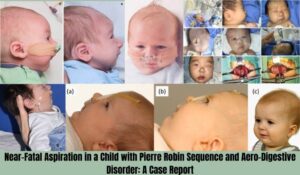Pierre Robin Sequence and Aero-Digestive Disorder!

Pierre Robin Sequence and Aero-Digestive Disorder
Introduction: Pierre Robin Sequence (PRS) is a congenital condition characterized by a small lower jaw (micrognathia) and a tongue that falls back into the throat (glossoptosis), often leading to airway obstruction and feeding difficulties. This condition poses significant challenges for managing airways, particularly in infants undergoing cleft palate repair. Postoperative care is critical but often underemphasized, especially when aero-digestive disorders are present. This case report discusses a near-fatal aspiration incident in a 17-month-old child with PRS and a partial cleft palate, highlighting the importance of comprehensive postoperative care and standardized guidelines.
Background of Pierre Robin Sequence
Children with PRS are at high risk for airway obstruction and aspiration due to their anatomical abnormalities. Feeding difficulties and failure to thrive (FTT) are common issues, exacerbated by factors like low socioeconomic status and gastroesophageal reflux. The complex interplay of dysfunction in the airway, swallowing mechanism, and digestive system defines aero-digestive disorders. These disorders make perioperative care challenging, requiring optimal overall health before surgery.
Incidence and Challenges:
- PRS incidence: 1 in 8,500 to 1 in 14,000 newborns annually
- PRS with aero-digestive complications: 1 in 20,000 births
- Difficulties include managing the suck-swallow-breathe sequence, especially in infants with cleft palate and velopharyngeal dysfunction
Case Presentation for Pierre Robin Sequence
A 17-month-old male weighing 9.6 kg, diagnosed with PRS and a partial cleft of the secondary palate, was scheduled for primary cleft palate repair under general anesthesia. The child had a history of coughing and gagging during feeding since birth. Postoperatively, the child was started on early supervised oral feeding as per the Enhanced Recovery After Surgery (ERAS) protocol, which initially was well-tolerated. However, on the first postoperative day, the child aspirated milk, leading to respiratory distress and desaturation (SpO2: 91%).
Key Clinical Observations about the Pierre Robin Sequence:
- Symptoms: Coughing, irritability, subcostal and substernal retractions
- Treatment: Nebulized albuterol and ipratropium bromide, oxygen support, intravenous fluids, and antibiotics
- Outcome: Significant clinical improvement within six hours; chest X-ray was normal
Oral feeds were temporarily discontinued, and intravenous fluids and antibiotics were administered. The child showed clinical improvement by the second postoperative day, with the resolution of most symptoms except for substernal retraction. Supervised oral feeds were restarted under close monitoring.
Discussion on Pierre Robin Sequence
Aero-digestive disorders complicate the coordinated functions of the airway and digestive systems, often leading to chronic respiratory issues from aspiration. These challenges persist even after surgical repair of cleft conditions, necessitating a multidisciplinary team approach for effective management.
Studies and Findings:
- Lee et al.: 35% incidence of aspiration pneumonia in children with cleft palate
- Muhammad et al.: 64.53% incidence of aspiration in children with cleft palate; 19.85% recurrent pneumonia; 7.09% mortality rate
- Fathy and Attia: Highlighted the lack of awareness among mothers about preventing aspiration
- Eridani-Ball and Brimble: Emphasized family-centered care and multidisciplinary teamwork
- Turlapati et al.: Only 21% of mothers reported improved feeding ability post-surgery
Paediatric ERAS protocols have improved postoperative recovery, including reduced opioid use and quicker resumption of oral intake. The protocols emphasize preoperative education, minimally invasive techniques, and multimodal analgesia.
Conclusion
This case report highlights the critical need for comprehensive postoperative care for children with PRS and aero-digestive disorders. A multidisciplinary team, including anaesthesiologists, surgeons, and speech-language pathologists, is essential for developing effective management strategies. Educating parents about feeding techniques and postoperative care protocols is equally crucial to minimize complications and ensure a safe recovery. The case underscores the necessity of standardizing postoperative care guidelines to improve outcomes for these vulnerable patients.
References
- Pierre Robin sequence and its associated complications: An overview. American Journal of Medical Genetics.
- Airway management in children with Pierre Robin sequence. Journal of Pediatric Anesthesia.
- Feeding and nutrition issues in children with Pierre Robin sequence. Pediatric Health.
- Challenges in managing aero-digestive disorders in infants. Journal of Pediatric Gastroenterology and Nutrition.
- Incidence of Pierre Robin sequence: A global review. Journal of Craniofacial Surgery.
- Comprehensive care for children with aero-digestive disorders. Pediatric Pulmonology.
- Clinical characteristics and airway management in infants with Pierre Robin sequence. International Journal of Pediatric Otorhinolaryngology.
- Impact of aero-digestive disorders on the quality of life in children. Journal of Pediatric Surgery.
- Lee, J., et al. (Year). Incidence of aspiration pneumonia in newborns with cleft palate. Journal of Pediatric Infectious Diseases.
- Muhammad, S., et al. (Year). Aspiration in children with cleft palate: A study from Pakistan. International Journal of Pediatric Otorhinolaryngology.
- Fathy, A., & Attia, M. (Year). Needs assessment of mothers with infants with cleft lip/palate. Journal of Maternal and Child Health.
- Eridani-Ball, R., & Brimble, S. (Year). Case study on the care of infants with cleft palate. Nursing and Healthcare International Journal.
- Turlapati, S., et al. (Year). Postoperative feeding outcomes in infants with cleft palate. Journal of Pediatric Surgery.
- De Vries, L., et al. (Year). Parent-reported feeding improvements after cleft palate surgery. Cleft Palate-Craniofacial Journal.
- Pediatric ERAS protocols and their impact on postoperative recovery. Pediatric Anesthesia.
- Role of aero-digestive centers in managing complex pediatric cases. Journal of Pediatric Gastroenterology and Nutrition.